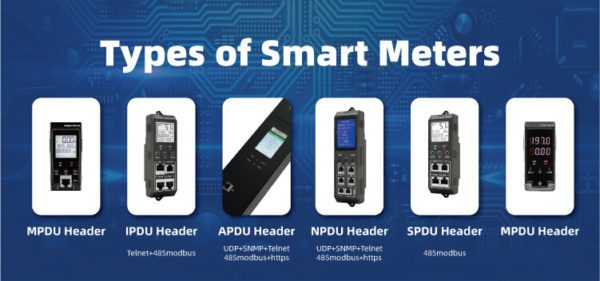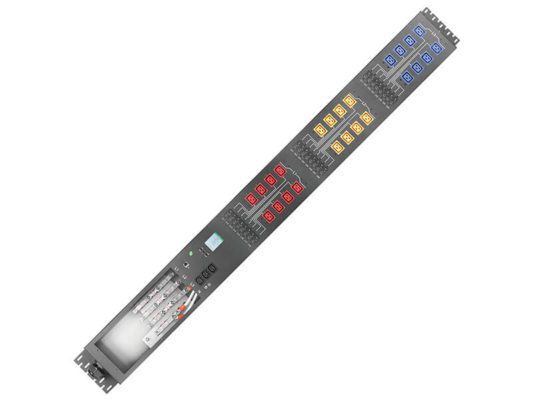Accessories List
What is a power distribution unit (PDU)?
A power distribution unit (PDU) is a device for controlling electrical power in a data center. The most basic PDUs are large power strips without surge protection. They are designed to provide standard electrical outlets for data center equipment and have no monitoring or remote access capabilities. More advanced PDUs provide real-time monitoring and remote access capabilities. called smart PDU.
PDUs manage and distribute electricity and are normally installed directly onto a rack. The power source could be alternating current (AC) or direct current (DC). It can come from an uninterruptible power supply, a utility power supplier, a generator, or another secondary power source. PDUs are also designed for power requirements that are typically much larger than home or office power strips and surge protectors.
Power distribution units ensure an organization’s IT infrastructure and data center are adequately powered.


What Is a Smart PDU?
A smart PDU, also known as an intelligent PDU, goes beyond distributing power to IT equipment within the data center. It is capable of monitoring, managing, and controlling power consumption on multiple devices. The smart PDU provides data center professionals with remote network access to real-time critical infrastructure data to help drive informed decision-making to ensure maximum availability and to meet important efficiency requirements. While there are two main types of smart PDUs, monitored and switched, each type has a variety of additional features that can be included to increase the critical information available from the device. Some of the key features include outlet level monitoring, environmental monitoring, alerts and alarms based on user-defined thresholds, and many more. These features minimize downtime and carry manufacturer-provided support to meet Service-Level Agreements (SLAs).
As data center environments become more dynamic and complex, many organizations are putting pressure on data center managers to improve availability while reducing costs and boosting efficiency. Next-generation high-density servers and networking equipment have increased the demand for higher rack densities and overall facility power requirements. While densities under 10kW per rack remain the norm, deployments at 15kW are typical in hyperscale facilities – and some are even nearing 25kW. High-density configurations provide improved levels of performance and capacity, but this creates the need for more effective power delivery. Thus, the features and functionality available in a smart PDU become increasingly important to achieve efficient power distribution to respond to changes in data center capacities and densities.
Benefits of Smart PDU
Benefits that come with intelligent power distribution units include the following:
- Improved data center management. Intelligent PDUs include features that aid with data center management, such as metering and remote capabilities.
- Reduced energy consumption. Monitoring power consumption enables organizations to better gauge power usage. Devices can also remotely turn off outlets when not in use to save power.
- Better control over power. Remote toggle functions are available to control individual outlets.
- Energy consumption data. Intelligent PDUs can monitor energy use and provide data on where and how energy is consumed.
Inquiry Now
What is a Fan?
A fan is a hardware device that keeps the overall computer or a computer device cool by circulating air to or from the computer or component.
The speed of a fan is measured in revolutions per minute or RPM, and the higher the RPM rating, the faster the fan spins. However, in many cases, the higher the RPM rating, the louder a Fan.
Types of fan found in a computer
Below is a listing of the different types of fans inside a computer, and the computer hardware components that require fans to function correctly.
- Case fan – a fan on the side of a computer case, inside the case. It helps circulate air in the computer case and blows hotter air out of the case.
- CPU fan – a fan on top of a computer processor. It helps pull and blow hot air off the processor, helping keep it cooler.
- Power supply fan – a fan located inside a power supply. The power supply fan blows hotter air out of the power supply and out of the computer.
- Video card fan – a fan on a video card. It helps keep more powerful video cards from overheating, especially when playing video games, editing videos, and doing other GPU or graphic-intensive tasks.
For a detailed description of the computer fan, you can refer to the Wikipedia article
Inquiry Now
What is a Server Rack Rails?
Server rack rails are a 4-post equipment mount accessory. Server rack rails are similar to 4-Post shelves, but there are no connections between the sides. It is typically used to mount equipment that is approximately 19 inches wide and cannot be mounted directly onto vertical mounting rails.
Types of server rails
OEM or server-specific rails are tailored for your exact server ensuring an easy and secure fit. These hold servers use shoulder screws and j-slots, which are able to provide a secure fit while using a minimum amount of space. Because of the many different configurations of server chassis, these usually only work with a few or as little as one server model.
Universal rails hold servers by the corners, meaning that shoulder screws are not required and any server will fit within the rail’s criteria. Many server-specific rails are only offered by the manufacturer at purchase or are discontinued within a set amount of years after release. Universal rails not only ensure that you will be able to mount any server but have something to rely on if your OEM rail stops working years after it is purchased.
Styles of server rails
When it comes to server rail functionality, there are three categories – toolless, fixed, and sliding. Universal rails are not latched in with shoulder screws, so they function as both fixed and sliding rails depending on whether or not it is locked with a thumb screw.
Toolless variants are available for both server-specific and universal rails. They make rail installation significantly faster, especially when done in bulk. The most popular rack hole type, square holes require cage nuts to install rails using threaded screws. Toolless rail kits are designed to latch onto square holes with tension, meaning you won’t need screws or cage nuts.
Using a fixed rail kit means that a server will be either locked in or detached. If you want to perform maintenance on a server mounted on a fixed rail, you will have to remove it completely which can be difficult if there is equipment on top and below the server. However, fixed rail kits generally use less metal and therefore are more cost-effective than slide rails.
Slide rails allow your server to be removed like a drawer. This means that you can perform maintenance while it is still attached to the rack and remove it even when other equipment surrounds it.
Inquiry Now
The people who have trusted us so far
I really appreciate the level of quality of the server chassis that I received on time. I may negotiate with you about my next project in the near future

Very happy with onechassis, their company amy is very professional, communication is fast and precise, so that our project can be completed sooner than expected

OneChassis is a very good service chassis factory. It does give my project what I need

I’ve been looking for a trusted server case manufacturer for our company. Finally, thanks to onechassis for the satisfactory help and service!

We have been working with onechassis for several years and have always been satisfied with the quality of their products. We still have several projects going on





